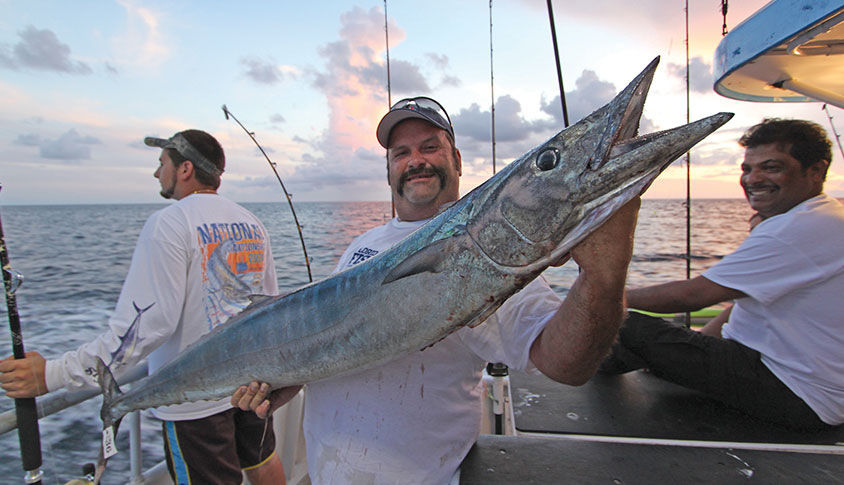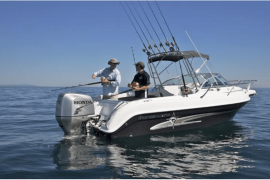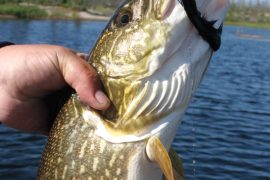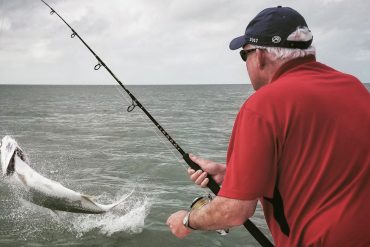An Unconventional Approach For Bagging Headboat ‘Hoo
Along the Gulf Coast of Florida, headboats depart from nearly every major port on an assortment of trips targeting a variety of species. The goal with most half- and full-day trips ranging from 4- to 12-hours is to put paying passengers on decent catches of snapper and grouper along with other assorted bottom dwellers, with the occasional king mackerel and dolphinfish also serving as prized targets. On top of these daily options specialty boats with extended range and overnight accommodations, including Yankee Capts sailing from Key West, Gulfstar from Tarpon Springs and Tampa’s Florida Fisherman II, embark on long-range adventures where they spend two, three and even four days on rich fishing grounds deep in the Gulf of Mexico.

While the primary focus of these extended excursions is to connect with queen snapper, snowy grouper and tilefish, the same sharp contours, drop offs and ledges resulting in quality bottom fishing also attract and support a vast network of forage species in the way of squid, flying fish, and bonito and blackfin tuna—all favorites on a pelagic predator’s dinner menu.
Find a headboat captain actually willing to devote an hour or two of trolling time during dawn and dusk around these defined edges, and the results can truly be fantastic.
Wahoo, in particular, inhabit these distant waters in surprising numbers. These fast fish regularly fall victim to lures and baits trolled by seasoned salts committed to taking advantage of every minute of fishing time as the vessels transit to and from the fishing grounds and relocate from spot-to-spot once on-scene. Find a headboat captain actually willing to devote an hour or two of trolling time during dawn and dusk around these defined edges, and the results can be fantastic.
While trolling for wahoo off a headboat certainly seems like an unconventional approach for taking these sinister speedsters, the tactic that you hear and read very little about is actually deadly effective as the vessels cover prime fishing grounds at 10-knots—the average cruising speed for headboats insistent on maximizing fuel efficiency in order to keep ticket prices as affordable as possible.
While policies vary from headboat to headboat, if you notify the captain or deckhands of your intentions in advance and permission is granted, then it’s time to get busy with adequate tackle and co-operation among fellow anglers—both key components for introducing prize wahoo to the fishbox. While some headboat captains may pull the throttles back when a fish is hooked on the troll, some captains act oblivious to what is happening in the stern and continue on their journey, leaving the angler with the rigorous chore of winching in a 40-lb. ‘hoo against a moving boat. This is exactly why line capacity and cranking power are both vital. The standard outfit is a beefy trolling stick matched to a 2-speed 50-wide loaded with 80-lb. monofilament.
Regarding lures, any typical wahoo lure rigged on wire or cable will entice blistering strikes. The Yo-Zuri Bonita and weighted Iland Lures fished way, way back are both hard-to-beat favorites. I’ve also seen quality ‘hoo fall victim to split-tail mullet and rigged ballyhoo, also presented a hundred yards back so don’t discount deploying the real McCoy to the shotgun position.
With cooperation among fellow anglers a prerequisite for landing quality fish on the move, common courtesy says clear the spread when the guy’s clicker to the right or left starts screaming. Once the wahoo is boated and the deckhands have cleared the cockpit, the remaining anglers are free to reset and wait their turn. Depending on the number of passengers equipped to get in on the action, a rotation consisting of two anglers per rail position may be necessary to ensure everyone gets an equal shot at quality fish.
Trolling for wahoo off a headboat isn’t for everyone and it is certainly not good practice on every trip. But when you’re way over the horizon and can sneak a lure off the stern at just the right time and place, you may experience a sneak attack from a blisteringly fast beast that will turn an already good trip into an unforgettable memory.
Tackle Tip
Conventional trolling rods are outfitted with roller guides for one specific reason: to prevent line wear. As monofilament rubs back and forth on a typical roller guide, heat is generated, which can ultimately weaken the line and lead to premature line failure. By adding a tiny wheel rotating around a bearing, the roller will actually spin with the line, thus greatly reducing heat and friction and maintaining the monofilament’s original integrity. AFTCO, the industry leader in roller guide technology, claims off-the-water tests have proven that monofilament will last up to 90 times longer when using roller guides.
Every AFTCO roller guide is protected from saltwater by a triple seal system, but the reality is that if you fish as often as you’d like, over time salt and grime build-up will prevent the small rollers from spinning freely. While a quick spray of lubricant is usually enough to solve the problem, annual roller guide maintenance is suggested for ensuring season after season of trouble-free performance.
One roller guide at a time, simply remove the pin and opposing screw with a pair of small flat head screwdrivers, taking care not to misplace the tiny pieces. With pin removed, the internal bearing and roller can easily be extracted, cleaned and lubed prior to reassembly.
An Unconventional Approach For Bagging Headboat ‘Hoo
Along the Gulf Coast of Florida, headboats depart from nearly every major port on an assortment of trips targeting a variety of species. The goal with most half- and full-day trips ranging from 4- to 12-hours is to put paying passengers on decent catches of snapper and grouper along with other assorted bottom dwellers, with the occasional king mackerel and dolphinfish also serving as prized targets. On top of these daily options specialty boats with extended range and overnight accommodations, including Yankee Capts sailing from Key West, Gulfstar from Tarpon Springs and Tampa’s Florida Fisherman II, embark on long-range adventures where they spend two, three and even four days on rich fishing grounds deep in the Gulf of Mexico.

Photo: FSF Mag
While the primary focus of these extended excursions is to connect with queen snapper, snowy grouper and tilefish, the same sharp contours, drop offs and ledges resulting in quality bottom fishing also attract and support a vast network of forage species in the way of squid, flying fish, and bonito and blackfin tuna—all favorites on a pelagic predator’s dinner menu.
Find a headboat captain actually willing to devote an hour or two of trolling time during dawn and dusk around these defined edges, and the results can truly be fantastic.
Wahoo, in particular, inhabit these distant waters in surprising numbers. These fast fish regularly fall victim to lures and baits trolled by seasoned salts committed to taking advantage of every minute of fishing time as the vessels transit to and from the fishing grounds and relocate from spot-to-spot once on-scene. Find a headboat captain actually willing to devote an hour or two of trolling time during dawn and dusk around these defined edges, and the results can be fantastic.
While trolling for wahoo off a headboat certainly seems like an unconventional approach for taking these sinister speedsters, the tactic that you hear and read very little about is actually deadly effective as the vessels cover prime fishing grounds at 10-knots—the average cruising speed for headboats insistent on maximizing fuel efficiency in order to keep ticket prices as affordable as possible.
While policies vary from headboat to headboat, if you notify the captain or deckhands of your intentions in advance and permission is granted, then it’s time to get busy with adequate tackle and co-operation among fellow anglers—both key components for introducing prize wahoo to the fishbox. While some headboat captains may pull the throttles back when a fish is hooked on the troll, some captains act oblivious to what is happening in the stern and continue on their journey, leaving the angler with the rigorous chore of winching in a 40-lb. ‘hoo against a moving boat. This is exactly why line capacity and cranking power are both vital. The standard outfit is a beefy trolling stick matched to a 2-speed 50-wide loaded with 80-lb. monofilament.
Regarding lures, any typical wahoo lure rigged on wire or cable will entice blistering strikes. The Yo-Zuri Bonita and weighted Iland Lures fished way, way back are both hard-to-beat favorites. I’ve also seen quality ‘hoo fall victim to split-tail mullet and rigged ballyhoo, also presented a hundred yards…





